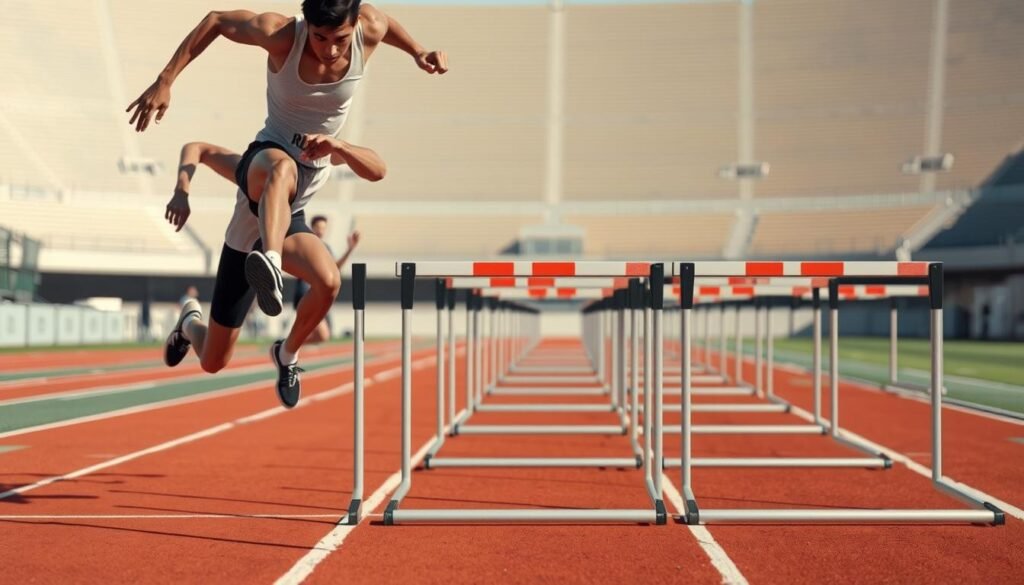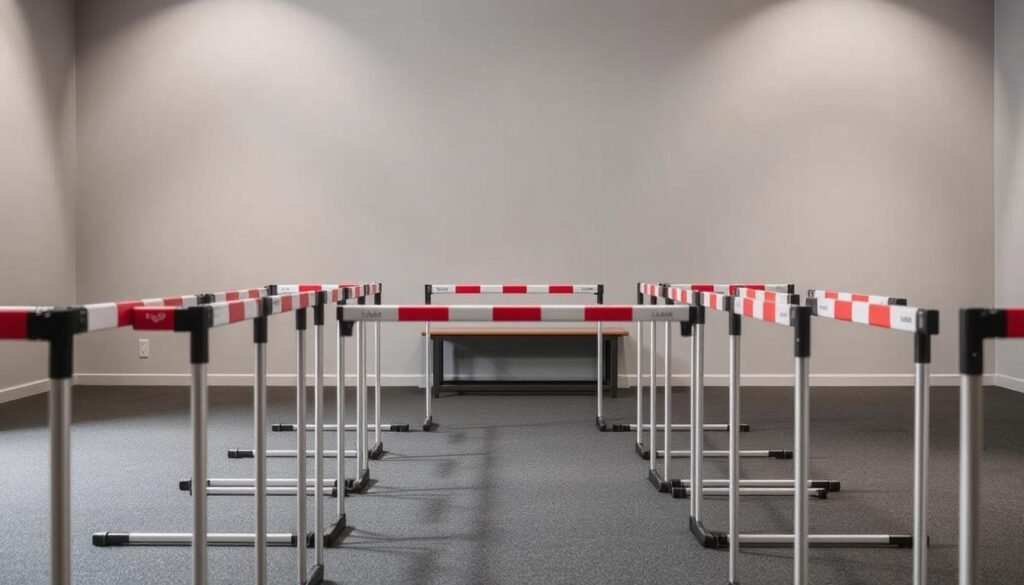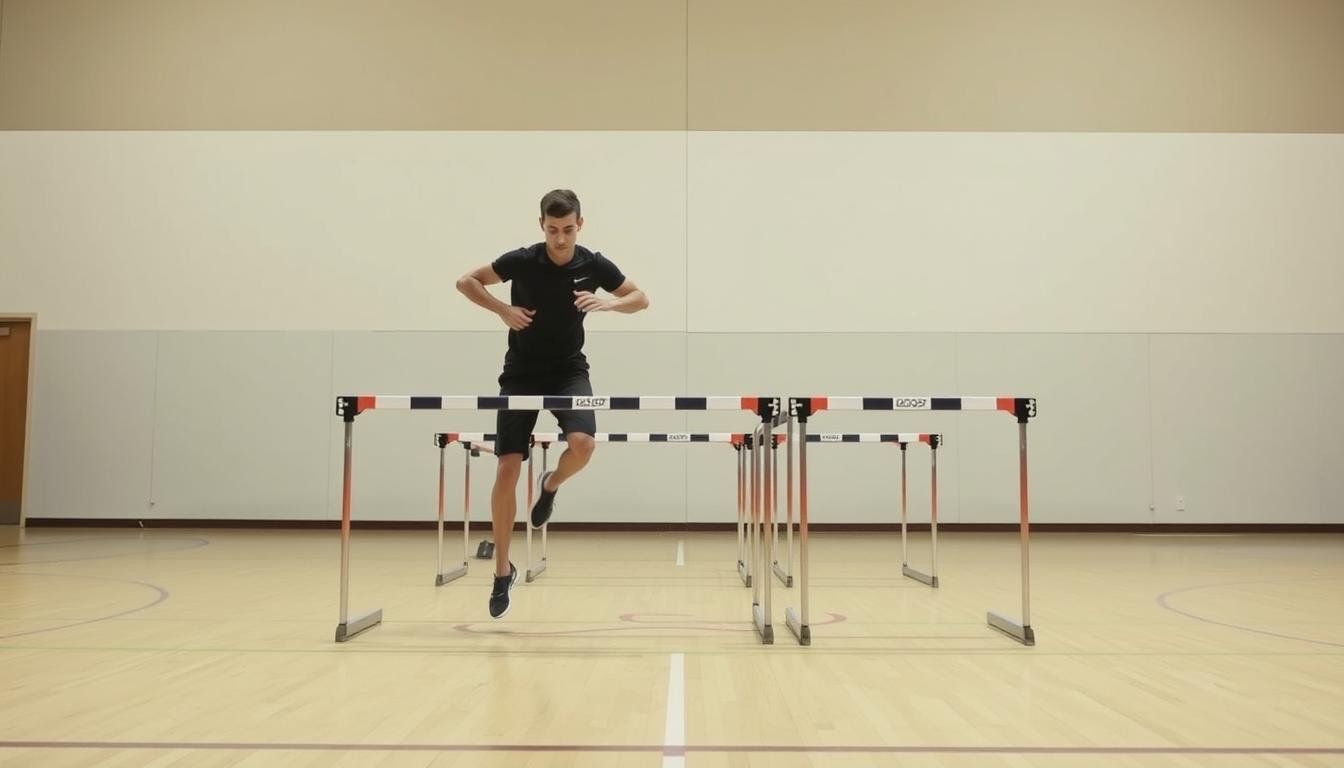Are you having trouble boosting your athletes’ hurdle skills? Teaching them the right way to hurdle is key for success in track and field.
Learning hurdle techniques needs a clear plan. It’s all about the right form, being agile, and moving fast. As a coach, you play a big role in teaching and improving these skills in your athletes.
A detailed hurdle technique tutorial can really help your athletes do better. By teaching coaching hurdle skills, you can help them clear hurdles with ease and confidence.
Key Takeaways
- Understand the basics of hurdle techniques
- Make a detailed coaching plan
- Work on the right form and agility training
- Boost speed and endurance with special drills
- Spot and fix common errors
Understanding the Fundamentals of Hurdle Techniques
Learning hurdle techniques is all about understanding the basics. As a coach or athlete, knowing these principles is key. It helps improve performance and lowers injury risk.
The Physics Behind Effective Hurdling
Hurdling involves complex physics, like motion, force, and speed. Athletes need to be fast and strong to clear hurdles well. The takeoff phase is very important for the athlete’s path over the hurdle. Knowing the physics helps find the best ways to clear hurdles.
Key Components of Successful Hurdle Clearance
Clearing hurdles well needs a few important things. These include good lead leg technique, effective takeoff mechanics, and smart landing strategies. The table below explains these and why they matter in hurdling.
| Component | Description | Importance |
|---|---|---|
| Lead Leg Technique | The lead leg is the first to clear the hurdle. It needs precise technique to avoid knocking it over. | High |
| Takeoff Mechanics | Good takeoff mechanics help athletes clear hurdles without losing too much speed. | High |
| Landing Strategies | Right landing techniques keep athletes moving and ready for the next hurdle. | Medium |

Understanding and mastering these basics can boost an athlete’s hurdle skills. Good teaching methods focus on these areas. This way, athletes can face hurdles with confidence and skill.
Essential Equipment and Safety Considerations
Hurdle training is more than just technique. It needs the right equipment and a safe place to train. To help your athletes train well and safely, focus on a few key areas.
Selecting the Right Hurdles for Different Skill Levels
Choosing the right hurdles is key. Beginners should start with lower hurdles to build confidence and skill. As they get better, you can raise the hurdles. Having various hurdles for different skill levels is vital.

Creating a Safe Training Environment
A safe place to train is essential. Make sure the area is free from obstacles and the ground is even and not slippery. Always check the hurdles for damage and keep them in good shape.
Proper Warm-up Protocols for Hurdle Training
Before starting hurdle drills, a good warm-up is needed. It should include dynamic stretching, leg swings, and short sprints. A proper warm-up helps prevent injuries and boosts performance.
- Dynamic stretching to loosen muscles
- Leg swings to improve flexibility
- Short sprints to increase heart rate and blood flow
Assessing Your Athletes’ Readiness for Hurdle Training
Checking if your athletes are ready for hurdle training is key. You must look at both their physical and mental sides.
Physical Prerequisites for Hurdling
Your athletes need strength, flexibility, and coordination. Flexibility in the hamstrings and hip flexors is vital for good technique. Also, check their mobility and stability.
Mental Preparation and Confidence Building
Mental prep is as important as physical. Athletes must feel sure they can clear hurdles. Use positive reinforcement and start with simple drills to build confidence.
Simple Tests to Evaluate Hurdling Ability
Tests like the standing long jump and single-leg squats
By checking these areas, you can make a better training plan for your athletes.
How to Teach Hurdle Techniques: A Step-by-Step Approach
To teach hurdle techniques well, break down the sequence into parts. This lets coaches focus on each part. It helps athletes build a solid foundation.
Breaking Down the Hurdle Sequence
The hurdle sequence has several key parts. These include the approach, takeoff, clearance, and landing. Coaches can give specific feedback and drills for each part.
Progressive Teaching Methodology
Using a progressive teaching method is key. It means teaching new skills in order. Athletes learn each part before moving on to the next.
Lead Leg Technique
The lead leg technique is very important. Coaches should teach athletes to keep their lead leg action consistent. The foot should be flexed, and the knee should drive forward. Proper lead leg technique helps athletes clear hurdles well and stay fast.
Trail Leg Mechanics
The trail leg is also key in hurdling. It helps with balance and power. Coaches should teach athletes to keep the trail leg close and move it smoothly forward.
Arm Action Coordination
Arm action is important for balance and rhythm. Coaches should teach athletes to relax their arms and move them with their legs. Effective arm action keeps athletes fast and in control between hurdles.
By following this step-by-step guide and using a progressive teaching method, coaches can help athletes improve their hurdle techniques. This will boost their overall performance.
Developing Proper Approach and Takeoff Mechanics
To clear hurdles well, athletes need to work on their approach and takeoff. This requires good technique, strength, and practice. A good approach is key to a successful hurdle jump.
Optimal Distance from the Hurdle
The distance from the hurdle at takeoff is very important. Athletes must find the optimal takeoff point to clear the hurdle fast. This spot changes based on the athlete’s skill and the hurdle’s height.
Body Positioning for Efficient Takeoff
Good takeoff mechanics start with the right body position. Athletes should keep their center of gravity low and use their legs for power. This helps them smoothly move into the hurdle jump.
Stride Pattern Adjustments
Athletes must adjust their stride to hit the right takeoff point. They might shorten or lengthen their strides to get it right. Trying different stride patterns helps them become more flexible and consistent.
| Aspect | Key Focus | Benefit |
|---|---|---|
| Optimal Distance | Finding the right takeoff point | Efficient hurdle clearance |
| Body Positioning | Maintaining a low center of gravity | Powerful takeoff mechanics |
| Stride Pattern | Adjusting strides for optimal takeoff | Consistency and flexibility |
Mastering the Clearance Phase
To excel in hurdling, athletes must focus on perfecting the clearance phase. This critical component of hurdling requires a combination of technique, strength, and practice. In this section, we will explore the key elements of effective hurdle clearance.
Lead Leg Extension and Drive
The lead leg is key in hurdle clearance. Athletes should extend their lead leg fully, keeping it straight. They should then drive it down towards the ground. This helps maintain momentum and ensures a smooth transition over the hurdle.
Upper Body Positioning Over the Hurdle
Proper upper body positioning is vital for maintaining balance and control during hurdle clearance. Athletes should keep their torso upright and their arms relaxed. They should avoid any twisting or turning motions that could disrupt their technique.
Common Clearance Errors and Corrections
Common errors during hurdle clearance include inadequate lead leg extension, poor upper body positioning, and insufficient drive. To correct these errors, coaches can use specific drills. These include lead leg exercises and hurdle walks to help athletes develop proper technique.
| Clearance Error | Correction |
|---|---|
| Inadequate lead leg extension | Lead leg exercises, hurdle walks |
| Poor upper body positioning | Core strengthening, balance drills |
| Insufficient drive | Sprint training, resistance band exercises |
Perfecting the Landing and Recovery
To excel in hurdling, athletes must focus on perfecting their landing and recovery techniques. This phase is critical because it directly impacts their ability to maintain speed and rhythm throughout the race.
Efficient Ground Contact Techniques
Efficient ground contact is vital for minimizing the loss of momentum after clearing a hurdle. Athletes should focus on landing with a midfoot or forefoot strike, avoiding heel contact to reduce braking forces. This technique helps in maintaining speed and reducing the risk of injury.
Maintaining Momentum Between Hurdles
Maintaining momentum is about smooth transition between hurdles. Athletes should work on quick turnover and powerful push-off from the ground after landing. This involves strengthening the muscles involved in the hip and leg drive.
Transitioning Back to Sprint Mechanics
Transitioning back to sprint mechanics after clearing a hurdle is essential for maintaining top-end speed. Athletes should practice sprinting between hurdles with a focus on proper sprint mechanics, such as maintaining posture, driving the knees, and pumping the arms.
By focusing on these aspects, athletes can significantly improve their hurdling performance. Coaches should incorporate drills that emphasize landing technique, quick recovery, and seamless transition into sprint mechanics.
Establishing Rhythm and Cadence Between Hurdles
Getting a smooth cadence is key for top hurdle performance. Athletes must find a steady rhythm between hurdles. This is vital for keeping speed and staying efficient.
Developing Consistent Three-Step Patterns
A consistent three-step pattern is essential for rhythm. Athletes should take the same steps between each hurdle, adjusting stride length if needed. This builds muscle memory, making rhythm easier in races.
Rhythm Drills and Training Methods
Several drills can boost hurdle rhythm. Practicing with different hurdle heights and spacings helps adapt to various rhythms. Using metronomes or music in training also helps maintain a steady cadence.
Adjusting to Different Hurdle Spacing
Athletes need to adjust their rhythm for different hurdle spacings. Training with varied hurdles helps athletes adapt their stride. This flexibility is key for different tracks and events.
| Drill Type | Purpose | Benefits |
|---|---|---|
| Variable Hurdle Spacing | Improve adaptability | Enhances rhythm flexibility |
| Rhythmic Hurdling | Develop consistent cadence | Improves overall hurdling efficiency |
By focusing on rhythm and cadence, athletes can greatly improve their hurdling. Consistent practice and varied training are essential for mastering rhythm between hurdles.
Essential Drills and Exercises for Hurdle Skill Development
To get better at hurdling, you need to mix technique drills with strength training. It’s key to use different training methods in practice sessions.
Technique-Focused Drills
Drills that focus on technique are vital for hurdling. They help athletes learn how to clear hurdles well.
Lead Leg Drills
Lead leg drills help athletes learn to lead with the right leg. Examples include:
- Lead leg walks over hurdles
- Lead leg runs over low hurdles
Trail Leg Drills
Trail leg drills work on the trail leg’s technique. They make sure it stays close to the lead leg. Examples include:
- Trail leg swings
- Trail leg runs over hurdles
Rhythm and Timing Exercises
Exercises that focus on rhythm and timing help athletes keep a steady pace. Examples include:
- 3-step rhythm drills
- Hurdle spacing variations
Strength and Conditioning Exercises for Hurdlers
Strength and conditioning are also important for hurdlers. They boost power, speed, and endurance.
| Exercise | Benefit |
|---|---|
| Squats | Improves leg strength |
| Lunges | Enhances balance and leg strength |
| Calf raises | Strengthens calf muscles |
Adding these drills and exercises to your training can greatly improve athletes’ hurdling skills.
Using Video Analysis and Feedback in Hurdle Training
Video analysis can show you things you can’t see with your eyes. It helps you understand your technique better. This way, you can make small changes to improve your performance.
Setting Up Effective Video Sessions
To get the most from video analysis, setting up your recording is key. Here are some important tips:
- Place the camera high to see your whole body as you hurdle.
- Make sure the camera is straight on to see your side view clearly.
- Choose a high frame rate to catch every detail of your movement.
Key Technical Points to Analyze
When you watch your video, look at these technical points:
- Approach and Takeoff: Check your speed and technique as you get close to the hurdle. Look at your takeoff position too.
- Clearance: Look at how you extend your lead leg and where your trail leg is. Also, check your body’s position over the hurdle.
- Landing and Recovery: See how you land and how smoothly you move back into your sprint.
Implementing Corrections Based on Visual Feedback
After you analyze your technique, use what you learn to make changes. Here’s how:
- Find specific areas to improve based on your video analysis.
- Plan how to work on these areas with drills and exercises.
- Record yourself again after making changes to see if they worked.
By using video analysis and feedback, you can significantly enhance your hurdling technique and performance.
Advanced Hurdle Training Strategies
To excel in hurdling, you need to use the latest training methods. These methods focus on race simulation and getting ready for competition. As athletes get better, they must work on their technique and mental game to perform their best.
Race Simulation Workouts
Race simulation workouts are key for getting athletes ready for competition. These workouts mimic the real racing conditions. They include the number of hurdles, how far apart they are, and how hard the race is.
By doing race simulation workouts, athletes can get better at endurance, technique, and performance.
Here’s an example of a race simulation workout:
| Workout Component | Description | Intensity |
|---|---|---|
| Warm-up | 30 minutes of light cardio and dynamic stretching | Low |
| Hurdle Drills | 3 sets of 10 reps, focusing on technique and speed | High |
| Race Simulation | 3-5 runs over 100m or 400m hurdles | Maximum |
| Cool-down | 20-30 minutes of stretching and foam rolling | Low |
Competitive Preparation Techniques
Getting ready for competition is vital in hurdling. It’s about creating a pre-competition routine to help athletes focus and prepare mentally. Techniques like visualization, positive self-talk, and breathing exercises can keep athletes calm and focused.
Psychological Aspects of Elite Hurdling
The mental side of elite hurdling is as important as the physical. Athletes need to build mental toughness and resilience to perform well under pressure. This can be done through mindfulness, self-reflection, and positive affirmations.
Conclusion
Teaching hurdle techniques to athletes needs a clear and step-by-step approach. Knowing the basics, checking if they’re ready, and using the right teaching methods are key. This helps them perform at their best.
Good teaching methods include breaking down the hurdle sequence and teaching the right approach and takeoff. Using hurdle coaching tips like video analysis and feedback helps athletes improve their technique. This boosts their overall performance.
To improve skills, try effective hurdle teaching methods like drills focused on technique and strength exercises. As a hurdle coach, your guidance is vital for your athletes’ success in the sport.
By following the steps in this article and staying dedicated to your athletes’ growth, you can help them succeed. They’ll reach their full height in hurdle events.



